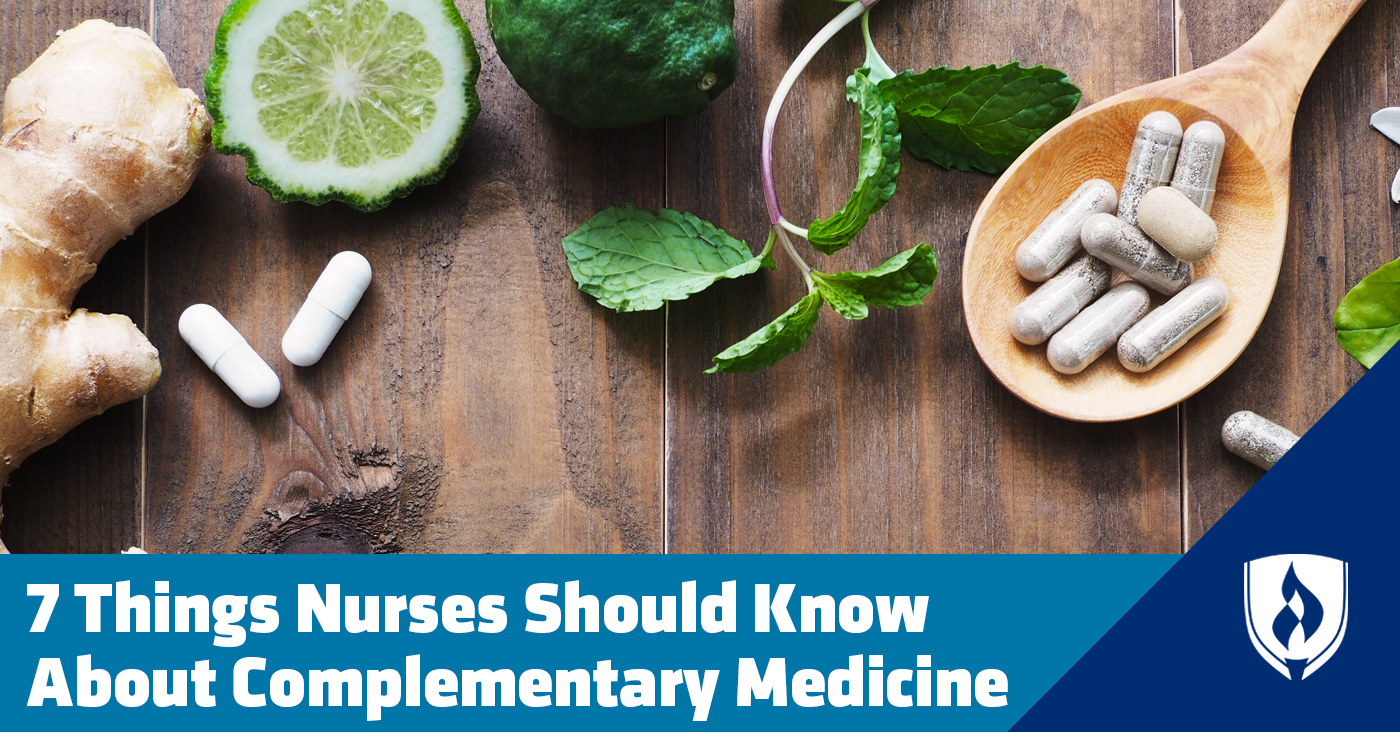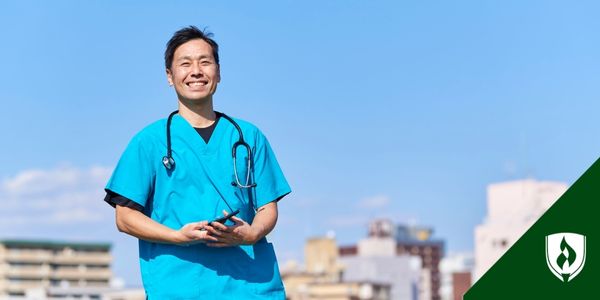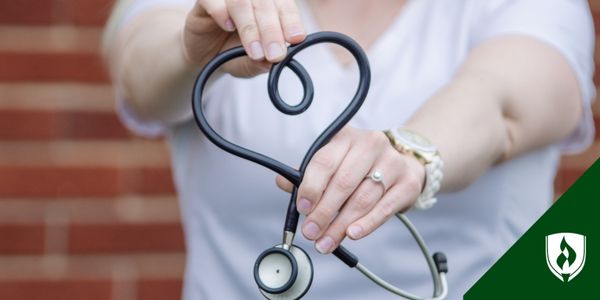
Willow bark infusions, ayurvedic medicine and aromatherapy are all terms you might run into while looking for pain relief these days. One benefit of the information age is a global database of health information available with the simple click of a mouse.
Complementary medicine and alternative medicine (CAM) are both terms getting thrown around the healthcare industry lately, and they aren’t going away anytime soon. “Public interest is exploding,” says CRNA Nick Angelis, co-founder of The Grecian Garden. “More people are choosing CAM for primary treatment, citing that going to doctors and buying medicine is too expensive.”
The increasing interest in complementary medicine has many people (including nurses) asking if alternative practices are safe and if changes are in store for the healthcare industry. Read on to learn the seven things you should know about complementary and alternative medicine, according to nurses.
Get Your Nursing School Questions Answered at a Nursing Information Session
1. People use the terms differently
Complementary medicine and alternative medicine can mean different things, but they are often blended into the umbrella acronym CAM. Complementary and alternative are both terms for health care options outside conventional western medicine, according to the American Holistic Nurses Association.
In his article “CAM vs. Traditional Medicine,” Angelis defines alternative medicine as a non-mainstream approach that replaces conventional medicine. Some of examples of this include administering acupuncture to improve digestion or relieve pain and practicing yoga or massage to alleviate bodily injury.
He points out, however, that most Americans do not rely on alternative medicine alone, but use it to complement their conventional health care. This is where the term complementary medicine came along. “CAM consists of natural products and various practices often blended together,” Angelis explains.
2. Some remedies have evidence behind them, while others don’t
“Nurses need to realize that CAM covers a wide spectrum, from completely fraudulent to miraculous,” Angelis says. He goes on to explain that many CAM approaches are validated by research but simply don't fit into the fast pace of our conventional health system.
It can be difficult for a CAM practice to get enough research funding to generate data in the first place. On the flip side, Angelis has seen many heavily-marketed products and supplements that have little evidence of usefulness. As with any industry, CAM has its share of hype and scammers.
Be warned! Most people realize that salesmen selling trench-coat ‘designer’ watches are sketchy. But with alternative and complementary medicine, it’s easy to get excited and start shelling out cash for products with no data behind them.
3. Self-diagnosing & self-medicating are still dangerous with CAM
“One disadvantage to CAM growth is people diagnosing themselves on the internet and demanding certain supplements,” Angelis says.
In this area where, for many reasons, empirical data is harder to find, patients might attempt to treat themselves based on product reviews or blog posts. CAM might seem safe to play around with, but patients still risk their health when they self-medicate. The publicized herbal tea fatalities in 1978, for example, came from non-experts attempting to medicate themselves with tea made from misidentified plants.
“Serious side effects from herbal medicine are much rarer than from prescription drugs, however,” Angelis points out. The greater concern is skipping necessary medical treatment for CAM without first consulting an expert.
4. Patients might not mention their use of CAM
“Most people don't tell nurses about their CAM use,” Angelis says. He adds that building a relationship with patients through non-judgmental communication is key to learning what herbs they take or what practices they engage in.
Nursing school doesn’t usually cover traditional Chinese medicine or homeopathic philosophies, which is why Angelis believes nurses might be hesitant to jump into the complementary medicine arena alongside their patients. But nurses who have no expertise in CAM can still build enough trust with their patients to be aware of what goes on outside their prescribed treatment.
5. You can use CAM in your clinic or hospital
It’s more common than you might think. “An act as simple as giving chamomile tea to calm a patient demonstrates traditional healing modalities,” says Courtney Allen-Gentry, the nursing coach known as Nurse Courtney.
Angelis himself incorporates several elements of CAM on the job: essential oils to calm the patient and prevent nausea in situations where more pharmacological agents could complicate things; acupressure points for nausea; and certain herbs to help detox the body from anesthesia. “I only discuss these matters with patients who seem receptive to it,” he says.
6. Understanding CAM can help you diagnose
Complementary medicine can help medical professionals look at the body from another angle, boosting the creative aspect of diagnosis and treatment. Jonathan Steele, RN and executive director of Water Cures, was treating a man with a hemoglobin count of 2.9 (about 80 percent loss of red blood cells.) The man was “as pale as anyone could possibly be,” and the hormone drug was not responding.
Steele pointed out that the body’s best way to get processed iron is through food. Molasses and peanut butter were the foods of choice in this case. “I ran to the store, got it certified by the pharmacy and gave it to the patient,” he explains. The following morning the patient’s hemoglobin count was up to 3.4, and the doctor told Steele that because of other complications, that food remedy saved the patient’s life.
7. The heart of CAM is remembering to care for the whole person
“When I went to nursing school, curriculum was just starting to move toward video education and away from the hands-on patient experience,” Allen-Gentry says. “Many of my colleagues never learned how to provide direct patient care in a manner which teaches the humanity of the act.” She sees many nurses thinking less about the dignity of their patients and more about their own feelings and situation.
“For instance, if you have a patient who is incontinent and you have to clean them up, most nurses complain about their own bad luck and fail to recognize the extreme powerlessness and vulnerability of the patient,” Allen-Gentry adds.
She considers CAM a return to not only some of the older traditions in healthcare, but to the root of why we have healthcare in the first place. “Showing love and demonstrating humanity should not be considered an alternative practice.”
Now you know…
The fact that you’re interested in complementary medicine suggests you have a healer’s heart. Have you ever considered becoming a nurse? Nurses have the chance to care for people in more ways than one, and you could be more prepared than you think.
Related Articles:
- Scoping out Healthcare Careers: Nursing vs. Medicine
- I Hate Bedside Nursing.. Now What?
- Types of Therapy: A Look at 7 Commonly Used Mental Health Treatments
- Does CNA Experience Help? What Future Nursing Students Should Know
- What Is Orthopedic Nursing: A Look Beyond the Bare Bones
- CVICU Nursing: A Specialty for Nurses with Heart




